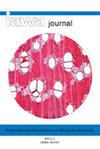利用X射线微纳计算机断层扫描技术对桉树形成层和发育中的木质部进行高级成像和定量
IF 3.5
3区 农林科学
Q2 FORESTRY
引用次数: 0
摘要
近年来,X射线计算机断层扫描(CT)作为一种非破坏性成像技术,在各个研究领域不断扩大。在木材研究中,X射线CT已被证明可用于研究树木复杂组织的三维结构研究。木材形成(即木材发生)始于形成层和随后分化的狭窄区域,这两者在植物生长和发育中都起着关键作用。然而,对桉树木材形成的动力学仍知之甚少,这在很大程度上是由于形成层的采样、成像和表征方面的挑战。因此,本研究的目的是提出一个工作流程,以评估使用X射线CT来表征和量化桉树形成层结构特性的可行性。通过监测形成层的结构发育,研究了Corymbia杂交苗在灌溉或干旱条件下的生长反应。为了跟踪形成层的微观结构变化,在处理前一天和处理后六天用X射线显微CT(μCT)对相同的幼苗进行成像。在最后一次X射线μCT扫描后,还应用了X射线纳米CT。利用图像分析技术,可以确定形成层的形态特征。X射线μCT显示,灌溉植物的形成层更大、更厚,而干旱的幼苗的形成层则薄得多。X射线纳米CT显示,与灌溉植物的形成层相比,干旱植物的形成膜体积明显较小,含有较小的细胞。使用光学显微镜验证CT结果,并证明从两种不同的CT技术获得的形成层宽度和细胞直径没有显著差异。这项研究的结果证明,X射线CT是一种有价值的工具,可以用来研究环境条件的变化对伞菌杂交幼苗复杂形成层结构的影响。本文章由计算机程序翻译,如有差异,请以英文原文为准。
Advanced imaging and quantification of the cambium and developing xylem in eucalypts using X-ray micro- and nano-computed tomography
In recent years, the popularity of X-ray computed tomography (CT), as a non-destructive imaging technique, has continued to expand in various research domains. In wood research, X-ray CT has proven to be useful for three-dimensional (3D) structural studies investigating the complex tissues of trees. Wood formation (i.e., xylogenesis) initiates in the cambium and a narrow zone of subsequent differentiation, both of which play key roles in plant growth and development. However, the dynamics of xylogenesis in eucalypts remain relatively poorly understood, in large part due to challenges in sampling, imaging, and characterizing the cambium. Therefore, the aim of this study was to present a workflow to evaluate the feasibility of using X-ray CT to characterize and quantify the structural properties of the cambium in eucalypts. The growth responses of Corymbia hybrid seedlings, exposed to either irrigated or droughted conditions, was investigated by monitoring the structural development of the cambium. To track microstructural changes in the cambium, the same seedlings were imaged with X-ray micro-CT (μCT) one day before the treatments and again six days after the respective treatments. After the last X-ray μCT scan, X-ray nano-CT was also applied. Using image analysis techniques, the morphological characteristics of the cambium could be determined. X-ray μCT displayed a larger, thicker cambial zone in irrigated plants, while a much thinner cambium was visible in droughted seedlings. X-ray nano-CT revealed that droughted plants were associated with a significantly () smaller cambium volume containing smaller cells, compared to the cambium of irrigated plants. Light microscopy was used to validate the CT results and demonstrated no significant () difference in the cambium width and cell diameter obtained from the two respective CT techniques. The findings of this study proved X-ray CT to be a valuable tool for examining the effect of changing environmental conditions on the complex cambium structure of Corymbia hybrid seedlings.
求助全文
通过发布文献求助,成功后即可免费获取论文全文。
去求助
来源期刊

IAWA Journal
农林科学-林学
CiteScore
3.40
自引率
15.80%
发文量
26
审稿时长
>36 weeks
期刊介绍:
The IAWA Journal is the only international periodical fully devoted to structure, function, identification and utilisation of wood and bark in trees, shrubs, lianas, palms, bamboo and herbs. Many papers are of a multidisciplinary nature, linking
 求助内容:
求助内容: 应助结果提醒方式:
应助结果提醒方式:


